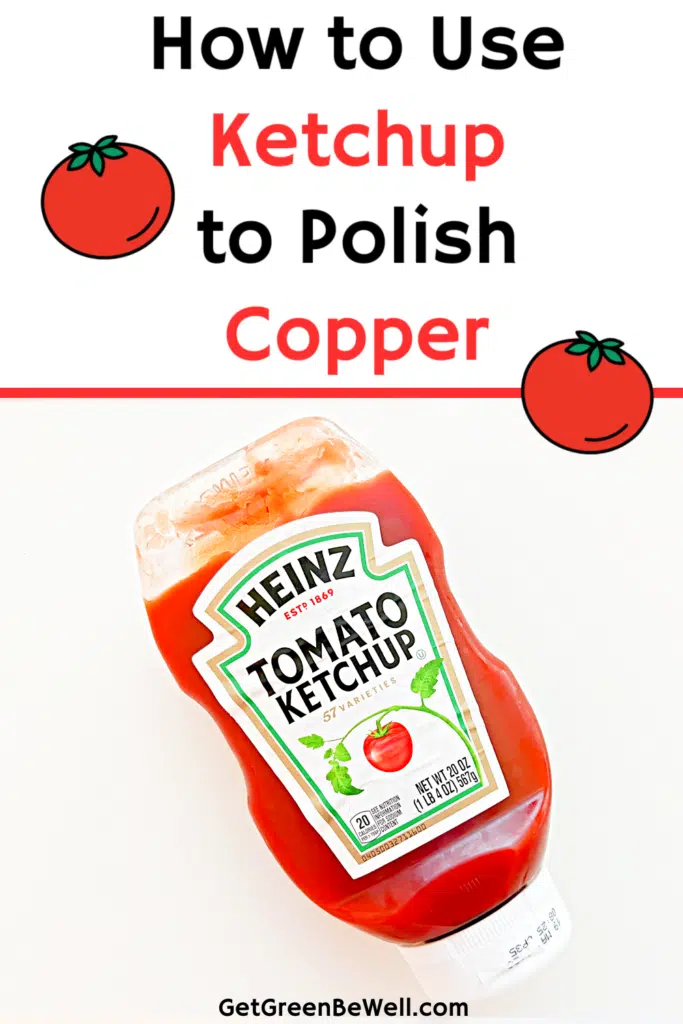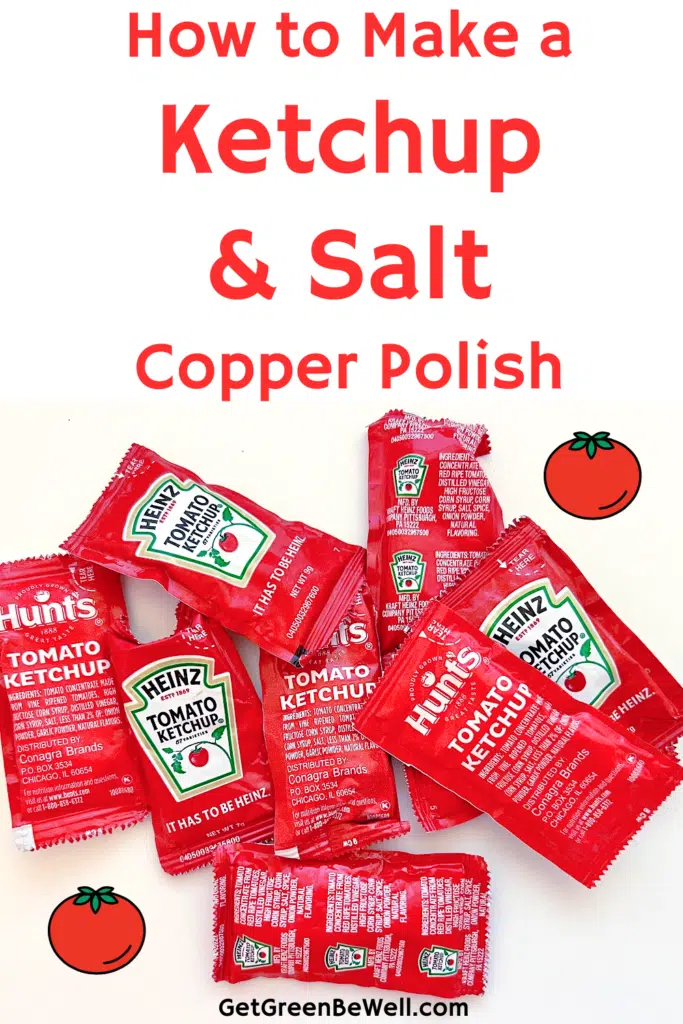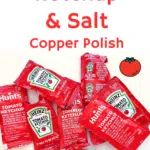Cleaning copper with ketchup might just be one of the easiest – and cheapest – green cleaning hacks at home.
If you have a bunch of ketchup packets in your kitchen drawers from take out meals, then this could be the smart way to use them up without being wasteful!

Why Ketchup Works to Clean Copper
Your first question probably is “Why does ketchup clean copper?”
Ketchup is often made with vinegar, and vinegar is great for cleaning because of its acetic acid. (By the way, you can use just vinegar to clean copper, too.)
Tomatoes are also acidic by nature, just like oranges are acidic. Both vinegar and tomatoes have a gentle acidity that removes tarnish and debris from the copper.
Which is why cleaning copper with ketchup is an amazing green cleaning hack!
Does Copper Need to Be Cleaned?
Copper is naturally going to develop a patina, which many call tarnish, over time. It happens when copper is exposed to air and develops a layer of copper oxide, which we call tarnish.
It’s the same for copper gutters and copper statues (like the Statue of Liberty).
There is nothing wrong with the patina that copper develops over time. In fact, that tarnish patina actually helps protect the copper surface.
Yet many people don’t like the look of tarnished copper (myself included). I like the bright, shiny copper look.
Polishing copper with ketchup will remove the patina and reveal shiny metal.
How to Clean Copper with Ketchup
There are many different types of copper items in your home. The most common are probably jewelry, copper mule mugs, or pots and pans.
All can be cleaned with ketchup. But you’ll probably want to do it in different ways.
P.S. Ketchup is also great at cleaning brass objects. So anything from door knockers to draw pulls to candlesticks can be cleaned in the same way as copper.
Jewelry
If you have copper jewelry, here’s how to clean copper with ketchup:
- Place the small jewelry items in a glass bowl.
- Cover with ketchup (just enough to cover the jewelry without wasting the ketchup).
- Let sit for 30 minutes.
- Rinse off the jewelry with water until the ketchup is completely removed.
- If needed, soak the copper jewelry again in ketchup for another 15 minutes.
- Dry with a soft cotton cloth.
Pots and Pans or Mugs
To clean a copper pot or pan with ketchup, follow these simple instructions:
- Squeeze ketchup onto a small surface area of the pot or pan.
- You can allow the ketchup to sit about 10-30 minutes to start working, or you can immediately start cleaning with the copper.
- Using a toothbrush (I like to use toothbrushes that need to be replaced in the bathroom for cleaning projects like this to repurpose them), scrub in small circles. Apply gentle pressure while scrubbing. Some people like to use a scouring pad, too, which is going to be much more rough. For the bottom of pots and pans this might be okay, but for mugs you probably don’t want to do that.
- Continue over the entire copper surface until all tarnish is off.
- Rinse off the ketchup with water.
- Buff the pot or pan with a dry cotton cloth.
Using Salt and Ketchup to Clean Copper
Usually ketchup and a scrubbing action (from either a brush or scouring pad) is enough to get the tarnish off of copper.
But perhaps you have a lot of patina on your copper. Or you just really want to scrub a copper pot well.
You can add extra cleaning power and still use non-toxic ingredients by adding salt to the ketchup.
A mixture of half ketchup and half table salt will make a scrub with a lot of grit to work off the copper tarnish.

Copper Cleaning Chemicals
Even though ketchup and vinegar are perfect for cleaning copper with their acetic acid, there are plenty of store-bought copper cleaning chemicals available to purchase.
Which seems silly because you’re spending a lot more money on a product you don’t need. And likely exposing yourself to unnecessary toxic chemicals.
Among the harsh chemicals that can be used in store-bought copper cleaning products and tarnish removers are:
- Acetone The same chemical found in nail polish remover.
- Hydrochloric Acid A very dangerous chemical.
- Muriatic Acid Another name for hydrochloric acid
Want More Green Cleaning Hacks?
Be sure to check out this simple green cleaning hack to use vinegar to clean your toilet. And how to use vinegar to clean your shower head!
If you prefer to buy a really great all-purpose non-toxic cleaner for the entire house, I can’t recommend Branch Basics highly enough! You can use one bottle throughout the entire home!

TERRY GOLDMAN
Friday 5th of June 2020
Tried ketchup on my copper kitchen sink and it worked like a charm! No harsh chemicals or smells compared to the kitchen copper cleaner that I've been using. This is my new go-to method for cleaning my sink from now on. Also key in keeping copper from dulling is to thoroughly dry the area once it's been washed.
Kimberly Button
Friday 5th of June 2020
Sounds great to hear, Terry. Thank you for sharing with us!
Chris
Wednesday 22nd of April 2020
I may have left ketchup on a copper pot too long. After buffing out and removing tarnish, which came off, the copper was cloudy or foggy looking and when I cleaned the pot and put it in the burner with water the bottom of the pot on the outside started to smell as the pot heated up.
Any suggestions on removing the ketchup residue?
Kimberly Button
Thursday 23rd of April 2020
Chris, you could use a wipe of white distilled vinegar to get off the residue. Then I'd wipe with water just to make sure that there's nothing left on the bottom of the pan.